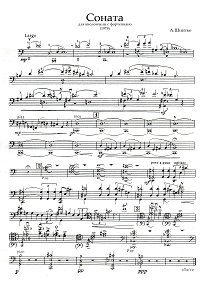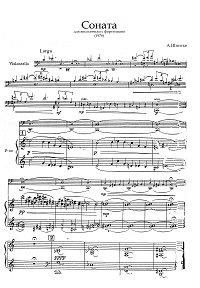Schnittke - Cello sonata (1978)
Schnittke - Cello sonata (1978). You can download the PDF sheet music Schnittke - Cello sonata (1978) on this page. The Sonata No. 1 for cello and piano is Schnittke's most often performed and recorded work. The three movements follow on from one another without any pause. As often happens in Schnittke's music, the composition contains certain extra-musical and symbolical elements. The First Cello Sonata (1978) has been a compulsory piece at many international cello competitions, including the Tchaikovsky Competition. The cello was an instrument that interested Schnittke throughout his life.
To view the first page of Schnittke - Cello sonata (1978) click the music sheet image.
|
| PDF format sheet music |
|
|
|
Cello part: 12 pages. 6835 K
|
Piano part: 34 pages. 25663 K
|
 |
 |
|
|
| Download PDF (14.99
€) |
Download PDF (14.99
€) |
| Alfred Schnittke started to write for cello as early as 1967 (Dialogue for cello and instrumental ensemble), and later completed Hymns I—IV for cello and ensemble (1975-9). Schnittke wrote his First Cello Sonata (1978) and the First Cello Concerto (1986) for Natalia Gutman, and his solo cello piece Klingende Buchstaben (1988) for Alexander Ivashkin. Madrigal fox. solo cello (1991), premiered by Natalia Gutman, was a tribute to the memory of Oleg Kagan. All Schnittke's other compositions for cello were inspired by and written for Mstislav Rostropovich, the great Russian cellist and a friend of Schnittke's. The opening of sonata offers a nostalgic allusion to classical style: the cello (and later the piano) plays the passage which clearly recalls the french horns' fifths of early Classical symphonies, shimmering on the border between major and minor, between light and dark. The furious, 'infernal' and motoric second movement, with its cruel and devilish waltz episodes, leads to a disastrous cluster, where all this nightmare collapses and disappears like a hallucination. The final Largo is a very long postscript, where the past (the first and second movements) is elevated to a new level - as often happens in life itself. The finale gives a new point of view, a wider horizon, where everything that has already happened looks different. The conclusion of the Sonata brings us back to the 'doubtful' shimmering between light and dark, back to the nostalgic allusion of the past, where material from the first and second movements comes together in rather a surreal context. |
|